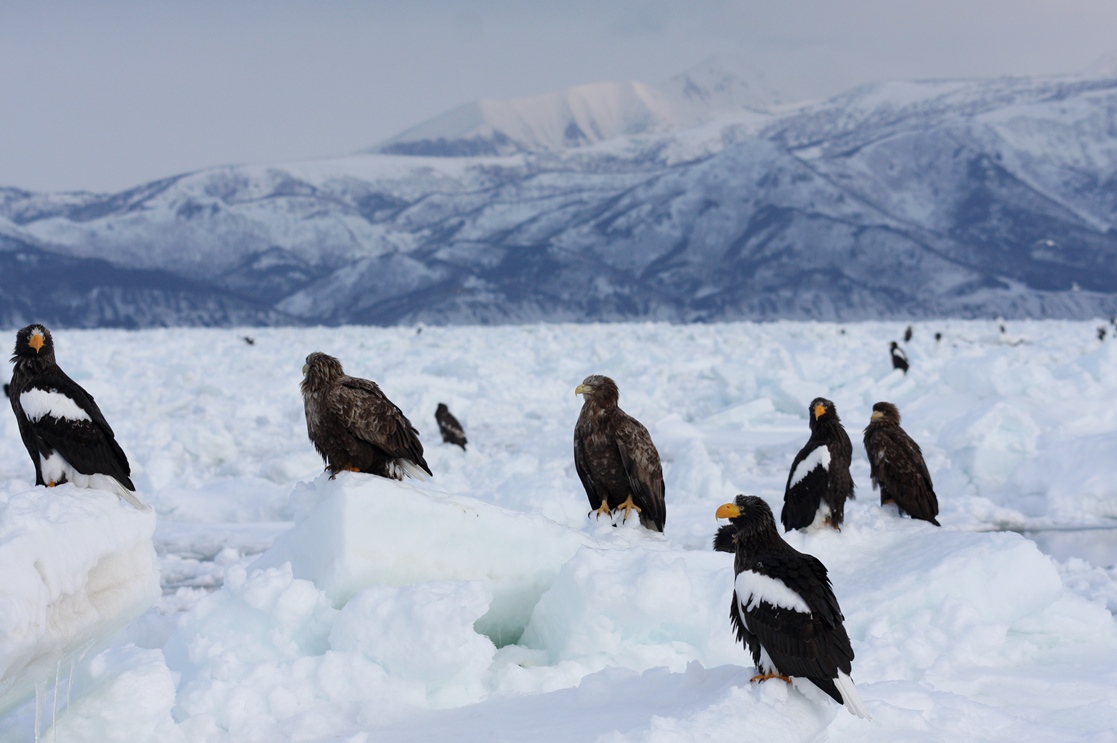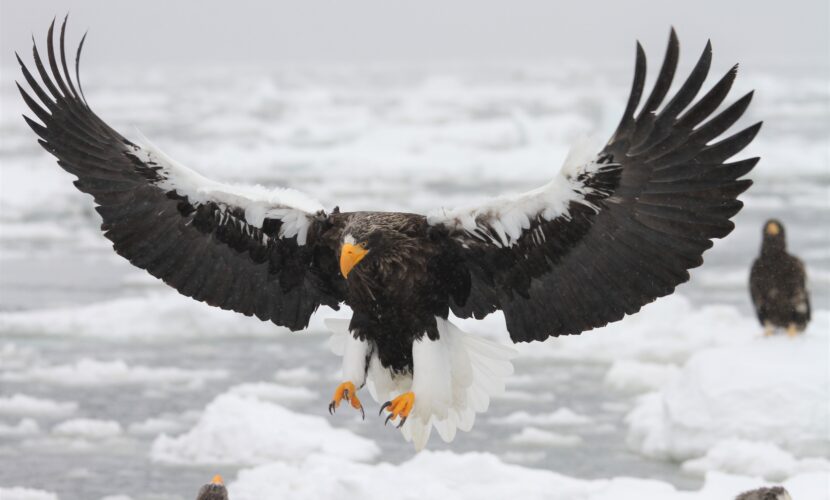取材:TRAVEL HOKKAIDO ピタ大畑
知床半島に位置する羅臼町は、北海道唯一の世界自然遺産です。 古くから昆布の産地として知られており、今では四季を通じて野生生物の楽園となっています。
冬になると羅臼では、ロシアのアムール川からオホーツク海を渡り、流氷の影響を受けた独特の生態系をたどるオジロワシやオオワシを迎えます。 この地域に多く生息するスケトウダラを餌にしており、2月上旬から3月上旬にかけては流氷の影響で根室海峡に到着するスケトウダラを観察するのに最適な環境です。
オオワシは、尾、肩、額に白い閃光を放つ黒い体と、2 メートルを超える翼幅という印象的な外観で知られる絶滅危惧種です。 極東ロシアで繁殖すると考えられていますが、世界中に 5000 羽ほどしか生息していないオオワシは、冬に繁殖地から北海道に 2000 羽も移動するとは信じられません。彼らは越冬地をオジロワシと共有します。オジロワシは、太い茶色の翼と短い白い尾が特徴です。 流氷の上でワシを目の前で観察できる世界で唯一の海で、2種のワシが頭上を舞う姿はまさに圧巻です。
海岸線の観察スポットからこれらの鳥を見たり写真を撮ったりすることもできますが、できるだけ近くにいる最良の方法の1つは、羅臼の小さな港から流氷と野生動物のクルーズに参加することです。
現在、さまざまな冬のツアーを提供するさまざまな地元のネイチャークルーズ会社があります。 前回の旅行では、知床ネイチャークルーズが運航する船のひとつ、エバーグリーン38に乗りました。 チームは経験豊富で、2006 年から羅臼でボート ツアーを開催しており、彼らの仕事に情熱を注いでいます。 彼らは地元の知識を駆使して、その日の天候や流氷の状況に応じて最適なルートを計画し、船がコースを航行するときにさまざまな野生生物がどこにいるかをすばやく指摘して説明します。
これらのツアーは、さまざまな旅行者にとって素晴らしい体験です。 もちろん、野生動物の写真撮影やバードウォッチングに特に熱心な人もいますが、このユニークで美しいエリアを間近で見たい人にも、これらのツアーはお勧めできると思います。 チームは地元の野生生物の習性とその地域の生態について多くのことを知っているため、野生生物に関する事前の知識がなくても、楽しみながら学ぶことができます。 数年前、初めて羅臼のネイチャークルーズに参加しました。 真冬だったので、どうなるかわかりませんでした。手元にまともなカメラがありませんでした。 でも、それは素晴らしい経験でした。この地域には素晴らしいものがあるので、私は毎年羅臼に戻り続けています。 冬のネイチャークルーズでは、撮影経験のある方からアマチュアの方までご参加いただけます。 あなたは幅広い年齢層を見つけるでしょう。 あなたは世界中の人々を見つけるでしょう。 子供から祖父母、巨大なカメラを持った一見プロの写真家の列、そしてスマートフォンを持った家族。 ワシや流氷を目当てにいろんな人が集まっていました。 知床ネイチャークルーズは、広いデッキを備えた設備の整ったボートを運航しており、ツアー全体を通してすべてのゲストが広大な景色を簡単に見ることができます。 50~80人乗りの船が満席の時でも、混み合ったり、海を眺めるのに苦労したりすることはありません。
流氷クルーズやバードウォッチングクルーズが盛んな冬季は、水平線に昇る朝日が見られる午前5時頃に羅臼を出発するのが一般的です。 その後、1 日を通してさらに 2 回のクルーズが行われます。1 回は午前 9 時、もう 1 回は午後 1 時です。 1月下旬から3月上旬までのピークシーズンでも、流氷の状態は日々変化します。 文字通りスカイラインを横切って見渡す限り流氷が広がる日もあれば、流氷が根室海峡にギリギリまで届く日もあり、その両方を経験した冬だからこそ言えること。 設定の、これは取る価値のあるボートトリップです。
国後島から昇る朝日を背景に、広大な流氷にとまるワシを見るのは、まさに幻想的な一日の始まりとしか言いようがありません。 海面に浮かぶ流氷に船が激突し、目の前のゴツゴツした氷に集まるワシの姿はもちろん息を呑むほど。
でも、前回の旅行では、流氷は海岸線にそれほど近づいていませんでした。 そして、私たちはまだワシを見ることができるかどうか疑問に思い、その経験がどのようなものになるかについて少し確信が持てませんでした。寒くても美しい一日でした。 私はエバーグリーン 38 の甲板に立って、少し威圧的なカメラを持ったカメラマンに囲まれていました。 太陽が沈み、水平線が前方に伸びたとき、私は空を見上げ、そのような信じられないほどの自然に直面して、自分の小ささにただ圧倒されました。私は以前、流氷が岸に近く、ボートが割れ目の中を通り抜けていたこのクルーズを行ったことがあります。 しかし、今日は流氷がないので、気を散らさずにワシを見て、ある意味で完全に消費されました。 これらの急降下する鳥は頭上を旋回し、私たちのボートに近づきます。 今日まで、それらがどれほど大きいかを理解したことがなかったと思います。 そして、この特定の日に彼らが多かったので、私たちは幸運でした。オジロワシとオオワシが一緒に飛んだり、急降下したりして魚を捕らえ、水面近くまで舞い上がり、再び空に舞い上がる様子は、信じられないほど美しいものでした。 私は彼らにとても圧倒されました。 彼らがそのような数の存在で私たちを優雅にしてくれること、そして私がそこに立って観察するのに十分な特権であること。
冬の羅臼です。 ある意味、なんとも言えない。 常に異なっていますが、常にとても壮観です。 北海道の冒険の一環として訪れるには、間違いなく特別な場所です。
知床ネイチャークルーズのネイチャークルーズに興味のある方は、https://www.e-shiretoko.com で情報を確認できます。



